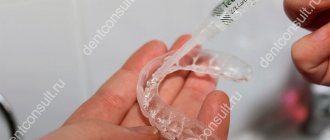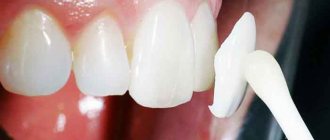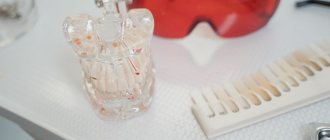Indications Contraindications How veneers are installed Pros and cons of veneering Veneers or braces Veneers or crowns
A beautiful, snow-white smile is one of the most common beauty standards. But perfectly straight teeth are quite rare. Some people have teeth that are too close to each other and crowd together, while others have teeth that are far apart, leaving gaps. Sometimes teeth are out of alignment or slightly tilted to the sides. Such defects are corrected by aesthetic dentistry. One of the common methods is veneering.
Veneers
– these are thin plates made of composite, ceramic or zirconium, which are used to correct a smile.
Place onlays on the front teeth, in the smile area. It is recommended to cover from 4 to 8 teeth
. The load on the lateral teeth is too strong for thin plates. It is better to put crowns on chewing teeth.
It is possible to install veneers on crooked teeth if certain conditions are met.
Indications for installation of veneers
- The presence of diastemas (gaps between the front teeth);
- chips, cracks, depressions, stains on the enamel;
- discoloration of teeth as a result of medical or dental treatment;
- single teeth protruding from a row;
- small, irregularly shaped teeth;
- slightly crooked teeth;
- gummy smile.
Veneers can correct the bite in the sense that in some cases, the onlays lift the bite, thus helping to bring back the “gone” lower jaw. This prevents problems with the temporomandibular joint and improves the quality of life.
To correct malocclusion, orthodontic treatment with braces or aligners (aligners) is necessary.
Is curvature of teeth a contraindication for installation?
Many patients would like to use veneers to hide all their imperfections at once, including uneven teeth. But the doctor may refuse an appointment. Why is this happening?
Here are the main contraindications to installing veneers.
- Unhealed foci of caries (but fillings, if they are installed well, will not hurt).
- Inflammatory diseases of the oral cavity, periodontal disease (until these problems are resolved, there is no need to carry out any aesthetic procedures).
- Malocclusion. Let's take a closer look here.
Veneers are plates that are installed using a special dental adhesive on the surface of the teeth. And teeth experience stress every day when chewing. The veneers themselves are not noticeable in any way, and patients with them eat exactly the same as before installation - there is no need to give up hard foods. Therefore, installed veneers must withstand daily “testing”. And if the bite is broken, then the cutting edges and chewing surfaces of the teeth close incorrectly. The load is distributed so that either the incisors or molars are overloaded. Because of this, the doctor simply cannot guarantee that the veneers will last as many years as they should.
This is a common practice: it is also impossible to install implants and even many types of crowns with an incorrect bite. For the same reason.
When is it better to refuse to correct your bite with veneers?
Like any intervention, veneering has limitations. The pads are not suitable for people suffering from bruxism. Grinding your teeth can ruin all your work. You should not install pads if you have the following pathologies in adults:
- periodontitis 3-4 degrees (teeth are very loose, gums are inflamed);
- thinning of enamel;
- significant damage to the crown (from 40%);
- lack of teeth in the area of prosthetics;
- severe curvature.
Sometimes it is possible to place veneers on crooked teeth after the condition improves or certain conditions are met. So, in case of infections, pregnancy, childhood, you just have to wait.
Pros and cons of straightening teeth with veneers and crowns
The advantages of such treatment are obvious. There is no need to wear braces and other orthodontic structures on the teeth for a long time. In most cases, you can get straight teeth in a month or less. If the teeth had an unattractive shape and color, then these defects will also be corrected by installing veneers or crowns. But, unfortunately, such treatment also has disadvantages, and quite significant ones. Even to install veneers on your teeth, you will have to grind them down, and the more pronounced the anomaly, the more dental tissue will have to be removed. Especially when crowns are required. In addition, straightening teeth with orthotics can be quite expensive. Thus, the installation of one ceramic veneer starts from 25,000 rubles in “economy” level dentistry.
How to install veneers
There are 2 ways to get a Hollywood smile:
- Install composite overlays directly in the doctor’s chair
- Make individual ceramic or zirconium plates based on an impression in the laboratory
The composite is inexpensive, installs quickly, and perfectly imitates enamel. Unfortunately, it is prone to shrinkage, absorbs pigments and wears out quickly.
Ceramic veneers are very durable, do not change color, and practically do not wear out. The main disadvantage is the cost.
The fact is that the process of making ceramic linings is expensive. It consists of several stages:
- Diagnosis and development of treatment plan
- Preparation: sanitation of the oral cavity, cleaning teeth from plaque
- Color selection
- Tooth preparation
- Taking impressions
- Record making
- Fitting
- Fixation
Consumables, the doctor's work, equipment, and the cost of the ceramics themselves make ceramic veneers more expensive than composite ones. But they do not need to be polished every 6 months and replaced every 3-5 years.
Types of veneers
Conventionally, experts divide all linings into several main types. They are divided by:
- Wearing time.
- The material used.
- The method of their manufacture.
Remember: all modern veneers are permanent, i.e. There are simply no removable pads. All modern advertising that promises to install removable veneers for a person at an attractive price is lying. Such products fall out of the mouth because... They are made for all patients according to one single template. And loss of linings often leads to injury to the oral cavity.
Do not forget that modern dentures can be worn in the oral cavity for 5-10 or even 20 years. But the final period depends on the material used and the method of manufacturing the structure. Moreover, with prolonged wear, the enamel under the veneers does not deteriorate and caries does not form. But it is important that the structure is installed correctly. That is why the patient should find out in advance whether braces are needed before veneers.
The overlays are fixed with a special adhesive compound. Moreover, it is built into natural enamel on both sides, an artificial microprosthesis. Overlays are made from completely different materials. It could be:
- Composite composition or filling mass reinforced with nanoparticles. Specialists call such structures “components”.
- Porcelain, simple ceramics. This is the most famous and popular material with a strength of 80-100 MPa. The strength of such a material is much lower than that of modern ceramic compositions.
- Leucite glass ceramics IPS Empress. This is a highly aesthetic material with a strength of 160 MPa. It allows you to create a natural design with a long wearing period.
- Lithium disilicate ceramics IPS E.max. The plates created from such material are called “ultraniers”. They are thin with a strength of 470 MPa.
- Ceramic composite. Such products are made of ceramics and composites. This is a modern material that has been actively used in recent years. Very thin overlays are made from it, for which the enamel does not even need to be ground.
- Zirconium dioxide, aluminum. These are the most durable materials. Their strength is over 650-1400 MPa. But they are painted unnaturally white, so they have poor transparency. Initially, such structures look very thick, so when installing, the doctor covers the top of the product with ceramics.
- Lumineers. These are very thin microprostheses with a thickness of 0.2 mm. Therefore, when installing them, the enamel is not ground down. But remember that you will have to install 6-8 pieces at once, because... Such plates are not installed one at a time. They are made from nanohybrid “secret” material. It is produced in one laboratory in the USA.
Do not forget that classic veneers are made using the indirect method, i.e. They are made from dental impressions in a dental laboratory. Therefore, the patient can ask the specialist working in the laboratory in advance whether it is necessary to install braces before the veneers. Moreover, the indirect method of manufacturing products is also divided into several main types:
- layer-by-layer application;
- sintering of liquid ceramic masses;
- pressing;
- milling the product on a computerized machine.
As mentioned above, an orthopedist is involved in the manufacture of these products. They are made in 1-2 weeks or 1-1.5 months.
Additionally, veneers are made using the direct method. In this case, the material is applied to the product directly in the patient’s mouth. Experts call this process “artistic restoration with a filling.” The patient is fitted with “therapeutic veneers”. The whole process lasts 1-2 hours. The installation is carried out by an orthopedist and dentist-therapist.
Pros and cons of veneering
Dental overlays for correcting malocclusion not only make your smile attractive, they increase self-esteem and improve your psychological state.
Advantages of veneers:
- Short installation times
. Composite onlays require 1 appointment, and ceramic onlays require 2-3. - Exact imitation of enamel
. The ability to transmit light makes ceramics indistinguishable from natural teeth - Biological inertia
. Allergy is not a contraindication. - Resistant to pigments and dyes
. Unlike natural teeth, ceramics do not change color over time. - Durability
. Ceramic compounds are several times stronger than composite ones. - Wear resistance
. If the recommendations are followed, ceramic linings last up to 20-25 years. Plates are replaced more often because the cement (adhesive) that attaches them to the teeth wears out.
97%
[1] Veneers are functioning perfectly 7 years after installation.
83%
[2] – after 20 years.
Several factors influence the lifespan of veneers:
- doctor's qualifications;
- mastery of technique;
- compliance with manufacturing and fixation technology;
- quality of materials;
- patient compliance with recommendations.
Therefore, it is recommended to choose large clinics with their own dental laboratories. The dentist and technician work together in such centers, discuss problems and find the best ways to solve them. The third member of the team is the patient.
It must be remembered that no veneer, even the most durable, can resist cracking nuts or biting wire. But curvature can be corrected with plates in a high-quality and long-term manner only if the recommendations are followed.
Disadvantages of veneers:
- The need for tooth preparation. Once you install veneers, you won’t be able to refuse them.
- High price. However, in the long term, ceramic veneers pay off. They do not need to be regularly polished and replaced with new ones.
Correcting a bite with braces has three main reasons for use:
- Significant tooth deformation;
- The presence of noticeable gaps between many teeth in a row;
- Obvious overlapping of teeth due to lack of space.
If the listed elements are weakly expressed, it is possible to install overlays that add external beauty. For example, when it is necessary to cover a single diastema or hide enamel irregularities resulting from filling. Severely developed disorders will become obstacles to the installation of veneers.
Only a doctor, during a face-to-face consultation, is able to assess the nature and degree of curvature of the teeth and, based on what he sees, express wishes to the patient in choosing the upcoming treatment.
What is better – correcting crooked teeth with veneers or braces?
Comparing these treatment approaches is difficult. Braces correct malocclusions, and veneers mask defects.
| Veneers | Braces | Aligners (aligners) | |
| Tooth preparation | The enamel is removed to a depth of 0.2-0.7 mm | Not carried out | Not carried out |
| Duration of treatment | Up to 2 weeks | Up to 2 years | Up to 3 years |
| Severity of defect | Lightweight | Deep | Deep |
| Diet changes | For 2-3 days | Yes, all the time of treatment | No |
| Care | No special care required, just be careful when using it | Careful hygiene required | Careful hygiene required |
When they say that veneers correct the bite, they mean the aesthetic aspect. Braces and aligners eliminate deep violations.
When veneers cannot be placed on crooked teeth
One of the most serious contraindications to straightening teeth with orthopedic structures is malocclusion - closing of the dentition. With occlusal anomalies, the interaction of the upper and lower teeth is disrupted, which has a destructive effect on them. Therefore, in case of malocclusion, it is not recommended to install any aesthetic restorations - they simply will not hold. Here, unfortunately, one cannot do without the necessary treatment with braces or orthognathic surgery. All other contraindications come down to the degree of complexity of the same crowding, curvature and position of the teeth. You can understand whether veneering is right for you or whether orthodontic treatment is required only after consultation with your doctor.
Installation process
The golden rule of orthodontics says: “before you engage in dental aesthetics, you need to restore their functionality.” Therefore, veneering should be preceded by sanitation of the oral cavity and restoration of lost functions of the dentofacial apparatus.
Sanitation involves treating all dental and periodontal diseases, or at least putting them into remission. Restoring functionality usually involves replacing missing teeth with dentures. Only after this work has been completed can restoration begin.
As already noted, there are two main technologies for installing veneers - direct and indirect. In case of abnormal position of the teeth, for example, tortoanomaly, the vestibular surface of the tooth is not tangential to the dental arch and requires alignment.
It is convenient to carry out the procedure using a composite, combining two operations - leveling the vestibular surface of the tooth and veneering it.
The work is carried out in the following order:
- Tooth cleaning. Performed with a circular brush and fluoride-free paste. You need to clean from the vestibular and oral sides.
- Determining the color of the restoration using color templates.
- Tooth preparation. First, with a marking bur, creating control grooves. Then use the usual method to remove the enamel to the depth of the marking grooves.
- Surface etching , acid rinsing, drying.
- Adhesive application , light curing.
- Applying a layer of dentin composite , modeling the surface taking into account the rotation of the tooth by distributing the composite composition over the surface of the tooth. Photocuring.
- Applying an enamel layer , light curing.
- contouring .
- Polishing and separation strips.
What is the purpose of skeletal support in orthodontics?
This publication presents the characteristics of biprognathic occlusion.
Here https://orto-info.ru/zubocheliustnye-anomalii/okklyuzii/pryamoy-prikus-v-ispravlenii.html we will discuss the tactics of treating direct bite.
Price issue
The main influence on the price is the type of material used (composite, ceramics, zirconium oxide) and the technology used. The brand (manufacturer) of the material is also important.
The cost of linings made from the same type of material, but from different manufacturers, can vary significantly. Only a specialist from the clinic where you contact to install veneers will tell you the exact price. The general price picture is as follows:
- Composite linings have the most affordable price ; depending on the manufacturer, it can range from 5 to 15 thousand rubles.
- Ceramic ones are more expensive. Their price, depending on the material and technology, can vary from 15 to 30 thousand rubles.
- The highest quality and most expensive are zirconium oxide veneers. Their cost starts from 18-20 thousand.
The video presents a specialist’s opinion on the possibility of correcting an overbite with veneers.
Cost of smile makeover
Prices for therapeutic veneers start from 5-7 thousand rubles for the restoration of 1 crooked tooth. As for classic overlays, their cost starts from 15-18 thousand rubles - also for 1 unit. Lumineers cost from 60-70 thousand rubles, and you need to install 6-8 pieces at a time - therefore the cost of a complete transformation is higher than all other microprostheses.
1Gurel G. Ceramic veneers. Art and Science, 2007.
Your questions and answers
QUESTION: I have a small gap between my front teeth on top, and my fangs are tilted slightly towards my lips. Can I get veneers to fix this, or are braces my only option? Elena
ANSWER Hello, Elena. Many patients correct crooked teeth (if they are small) with veneers. It's fast - faster than correction with braces or aligners. And absolutely everyone is happy with the effect. Therefore, if you want to know the exact answer to your question, visit the dentists in person. It is better to go to both an orthodontist and an orthopedist, take a panoramic photo and tomography of the jaw. Then it will be clear whether you can get veneers or still reserve time and carry out correction with braces.
Author: Chernov A. R. (Thank you for your help in writing the article and the information provided)
Price
The cheapest are composite veneers. They are easy to install; this is done by the doctor during the appointment. They are short-lived, easily change color, and become covered with cracks. Longer service life for ceramic veneers. They are resistant to coloring pigments, quite thin, which means minimal dental treatment is required. Zirconium veneers are the strongest, but also the most voluminous. The preparation for them is more pronounced, and it is quite difficult to secure them. Ultra-thin veneers require more effort, which is why they are the most expensive. But the enamel is practically not ground off underneath them.
What is better - braces or veneers?
Both techniques are suitable for aesthetic restoration, but it would be incorrect to make direct comparisons between them.
Braces are an orthopedic mechanism, the installation of which allows you to create directed pressure on defective units of the dentition. With the help of braces, curved elements are gradually returned to their natural anatomical position, the bite is leveled, and the muscle memory necessary to maintain correct occlusion is formed. At the end of the treatment course, the duration of which depends on the condition of the teeth at the time of installation, the device is replaced with a retainer - an elastic mouth guard that prevents recurrence of the defect.
The advantages of braces are obvious: their use does not require enamel preparation, and the achieved result in the form of an even dentition lasts a lifetime. At the same time, it must be taken into account that wearing the system for several months is a difficult task, both from a psychological and physical point of view.
Veneers, in turn, belong to the category of microprostheses, which is determined by their functional properties. Products, the thickness of which does not exceed one millimeter, are fixed on the front part of the crown, completely covering it from external influences, and providing the necessary shape, shade and strength of the unit.
At the same time, in order for the installed veneers to look natural, the crown enamel must be prepared by removing part of the protective layer. Since dental tissue is incapable of regeneration, the procedure is irreversible, so once choosing this technique, the patient will be forced to periodically - at least every ten years - update the plate to maintain aesthetics.
In terms of cost, getting braces is less expensive than getting veneers. The price for a correction course involving the use of an orthodontic apparatus starts from 65 thousand rubles, while prosthetics with ceramic onlays costs 30-35 thousand per unit. There is also a more budget option - composite veneers, which cost from 3 to 8 thousand, but the lifespan of such structures does not exceed 1-2 years.
Correction of teeth with veneers at the Novodent clinic
If you decide to correct uneven teeth with veneers, you should remember that the quality of this procedure will determine your appearance, ease of use, health and long-term use of the veneers. In order for the session to go smoothly, and for the correction of crooked teeth with veneers to give the expected positive result, you need to wisely choose a clinic and a specialist who will provide you with this service.
Why should you choose Novodent clinic?
- We use modern equipment.
- All materials for any procedures are certified and meet quality standards.
- We employ specialists with extensive experience in various types of dental treatment.
- Comfortable service and prompt implementation of necessary diagnostic, preventive or therapeutic actions.
- Pleasant value for money.
- A huge database of satisfied and happy patients.
Beauty and health are what every person dreams of. And, fortunately, modern medicine can help with this. Become a patient of our clinic and get not only correction of uneven teeth with veneers, but also a chic, charming, and most importantly healthy smile.
When are crowns used to straighten teeth?
To add beauty to teeth that have undergone destruction or complex treatment with a change in integrity and benign appearance, in addition to veneers, crowns have also been invented.
Crowns are designed to cover not only the front part of the tooth. Having volume, the structures restore the anatomical shape of the tooth and its functionality. Therefore, they are installed on both incisors and chewing teeth.
Various materials are used to make such nozzles. Representatives of the latest generations of crowns are units made of ceramics, metal-ceramics or zirconium dioxide. The strength of the last two options is superior to ceramic modules, allowing them to be used even on massive jaws. But it is not recommended to correct the front teeth, for example, with metal-ceramics - due to the visibility of the metal base. For this purpose, crowns made of zirconium dioxide or Emax material are used.
At the appointment, the doctor will help you decide on the crown material, based on the distance of the tooth from the smile zone, the degree of its deformation and the patient’s financial capabilities.
Possible problems
Complications when correcting a bite with veneers can arise for several reasons:
- Medical errors (ignoring indications, incorrectly chosen technique, violation of tissue preparation technology, etc.).
- Failure of the patient to comply with the doctor’s recommendations (eating too solid food, bad habits, passion for extreme sports).
- Poor oral hygiene.
Complications during the treatment process most often occur at the preparation stage. The most dangerous are burns from overheating and accidental opening of the pulp, ending in pulpitis.
To avoid this, the following rules must be followed:
- Grinding of the tooth is carried out intermittently, at the recommended speed of the bur, with the supply of coolant.
- Control the layer of material being removed.
- Take into account the anatomy of the teeth, the location of the pulp horn.
- Strictly comply with aseptic requirements.
Other complications include:
- Increased sensitivity of the restored tooth - a painful reaction to cold, hot, sour, sweet.
The syndrome occurs when too much tissue is removed during preparation or when the enamel is pathologically thin. To reduce sensitivity at the preparation stage, desensitizers are used - substances that seal the dental tubules. - Changing the color of products . Typically observed in composite structures due to ingestion of coloring foods. Smoking can also lead to darkening of the restoration.
- Chips and cracks of records .
They can occur both due to poor-quality material and due to violation of the rules for using veneers (too hard food, injuries). Composite structures can be restored in the patient's mouth. Ceramic ones cannot be repaired; if there is significant damage, they must be ground off and new ones installed.
Service life and care
When thinking about whether it is possible to correct crooked teeth with veneers, you need to remember that this “correction” is not permanent (like braces). Although even after braces you will have to wear retainers for a long time - special devices that restrain “spreading”. After some time, fillings or microprostheses will have to be replaced. And also take proper care of them to maximize their service life.
DENTAL PROSTHESIS ON 4 IMPLANTS - from RUR 170,000.
The price includes all procedures for installing Osstem implants (South Korea), including anesthesia and diagnostics.
Hurry up to sign up for a free consultation and fix your prices.
Call now or request a call
Opening hours: 24 hours a day - seven days a week
Thus, therapeutic restorations last an average of 5-7 years. But since their surface quickly loses its “smoothness” and begins to fade and absorb dyes, you will have to give up brightly colored products and regularly visit the dentist (at least 2 times a year) to remove the accumulated plaque and carry out polishing.
For classic ceramic, ceramic-composite and zirconium dioxide onlays, the service life starts at 10 years. But they can easily last more than 15 years if professionally manufactured and installed. Therefore, first of all, you need to approach the choice of an orthopedic dentist wisely. Restorations, despite their strength, should be treated with care - exclude hard foods (or cut them into pieces first), do not chew chewing gum, taffy, chew candy, and do not bite off pieces of hard foods with your front teeth. It is advisable to come to the clinic for a medical examination once a year.
Adaptation period
The patient needs to visit the dentist 2 weeks after installation of veneers. A control study is carried out, during which the doctor finds out the following circumstances:
- what is the condition of the linings (how do they hold up);
- is there an allergic reaction;
- Is there an inflammatory process?
On average, a person gets used to the installed microprostheses within 3 weeks.
It is important to properly care for your veneers. This will increase their efficiency and extend their service life. After such a restoration, doctors recommend adhering to the following rules:
- avoid increased loads on chewing surfaces;
- carefully monitor oral hygiene;
- Visit your dentist regularly (at least once every six months).
Ways to correct bite in adults
Many patients believe that correction of occlusion is possible only in childhood. Therefore, if there are any anomalies, you can forget about veneering once and for all. But this is not so, because it is perfectly possible to correct the position of teeth even after 40 years:
Braces are usually used to correct significant malocclusions.
They allow you to completely control the treatment process. Braces designs are made of metal, ceramics, and sapphire. By design, braces are divided into:
- ligature
(equipped with a special elastic band that secures the lock on the arch); - lingual
(installed on the inside of the dentition); - self-ligating
(they look miniature and do not require frequent visits to the orthodontist for correction).
As an alternative to braces, removable orthodontic appliances such as mouth guards or aligners may be used in some clinical cases. They allow you to solve aesthetic and functional problems of the dentition.
Transparent aligners move the dentition and force the teeth into the correct position. They can be removed before eating, which allows you to completely preserve your gastronomic habits.
Mouthguards can be used as the primary means of correcting occlusion abnormalities. They can also be used during the retention period (consolidation of results) after removing braces.











